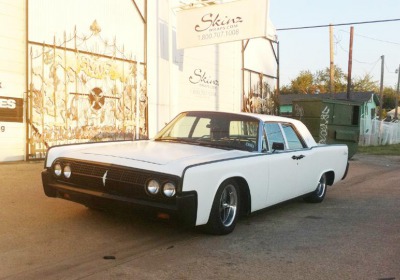Rhonda Renaissance Part 2: Paint vs. vinyl
Wed, 28 Mar 2012
We dispensed with the basics in Part 1 on Monday: There's a 1963 Pontiac StarChief in the parking garage of Autoweek HQ. It needs of a new coat of something for the summer, so let's explore some of the options confronting today's refinish customers, where candy paint is no longer the only game in town.
Let's start with vinyl wraps: We've seen them, felt them and picked at them at shows and in shops. The general consensus is that they look fantastic--as long as they're done properly. Vinyl isn't constrained by the same physical and chemical limitations that paint is. It's also a safe way to customize your car considering that it can be removed as fast as it's installed. Colors can be glossy or flat, patterns can be included, and if you want your car finished in Sultan of Brunei chrome, vinyl can do that, too.
Peter Salaverry swears by the stuff. He's the CEO of SkinzWraps, a company that's been at the leading edge of auto-vinyl technology since 2001. SkinzWraps created the first matte-black vinyl wrap in 2008. Since then the company has added new colors, including Pencil, Frozen Rosso Corsa and Burnt Orange. SkinzWraps also makes wrap in what's called Storm Trooper White, which has a medium matte look. In addition to consumer work, the company does wraps for the Ferrari Challenge race series, the American Le Mans Series and IMSA.
The advantages to vinyl are many, according to Salaverry.
“It's easy to fix, for one. If a painter smudges a panel at the tail end of the car, it needs to be cleaned up and repainted. If a vinyl-covered car gets a scratch, we just remove the piece and install a new one,” Salaverry said.
It can also be less expensive than painting, depending on the level of quality you're seeking. A show-quality coat of primer, paint and clear can easily cost upwards of $10,000 with bodywork and color sanding. A high-quality vinyl wrap can cost about half that with little installation time. Sure, you can get the cheapo respray over at your local body shop, but the longevity of the paint could become an issue, as could quality.
Paint has its own advantages. Harvey Ledesma of Kustom Creations in Sterling Heights, Mich., has been working with pigment for 16 years. He's done movie cars for as little as $1,200 and custom jobs for as much as $26,000. In fact, Ledesma and Kustom Creations were responsible for the matte-red Chevrolet Sonic Boom seen at the 2011 SEMA show.
“The sun will damage wraps more than paint,” Ledesma said. “With new technology, a good paint job can easily last 10 to 20 years if it's taken care of properly.”
Matte finishes bring an even bigger level of complexity, whether it's paint or vinyl.
“Scratches can't be touched up, and you can't get oil on it,” Ledesma said of a matte finish. “You can't use wax-based cleaners, and you can't rub it too much or it'll start to shine. But soap and water work just fine.”
“Definitely no waxes,” Salaverry adds. “And no tire cleaners that don't wash off before driving. That stuff can sling on to your finish and damage the matte.”
Additionally, you can't use mechanical means to polish it or leave insect remains, bird droppings or tar spots on the surface for a long time. In other words, as good as they look, matte finishes take a lot of dedication.
So those are the options we're considering for Big Rhonda: Go with wrap or paint? Matte or glossy? Inexpensive or bank-breaking?
Come back on Friday for Part 3, when we'll consider the overall style we're going for, old school versus old cool.
By Jake Lingeman

